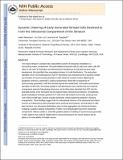| dc.contributor.author | Newman, Helen | |
| dc.contributor.author | Liu, Fu-Chin | |
| dc.contributor.author | Graybiel, Ann M. | |
| dc.date.accessioned | 2016-05-09T14:34:13Z | |
| dc.date.available | 2016-05-09T14:34:13Z | |
| dc.date.issued | 2015-01 | |
| dc.date.submitted | 2014-12 | |
| dc.identifier.issn | 00219967 | |
| dc.identifier.issn | 1096-9861 | |
| dc.identifier.uri | http://hdl.handle.net/1721.1/102427 | |
| dc.description.abstract | The mature striatum is divided into a labyrinthine system of striosomes embedded in a surrounding matrix compartment. We pulse-labeled striosomal cells (S cells) and matrix cells (M cells) in cats with [superscript 3]H-thymidine and followed their distributions during fetal and postnatal development. We identified three maturational phases in S-cell distributions. The early phase (sampled at embryonic day [E]27–E35 following E24-E28 [superscript 3]H-thymidine) was characterized by a transient medial accumulation of synchronously generated S cells within the caudate nucleus adjoining the ganglionic eminence, potentially a waiting compartment. Band-like arrangements of synchronously generated S cells then formed beyond this medial band. During the second phase (sampled at E38–E45), the loosely banded S-cell distributions were transformed into clustered arrangements typical of developing striosomes. In the third phase (sampled from E52 into the postnatal period), these developed into the typical mature striosomal architecture. At adulthood, gentle mediolateral birthdate-gradients in S cells were still evident, but M cells, produced over mid to late prenatal ages, became broadly distributed, without apparent gradients or banding arrangements. These findings suggest that the maturational histories of the striosomal and matrix neurons are influenced by their generation times and local environments, and that future S cells have transient, nonstriosomal distributions prior to their aggregation into striosomal clusters, including a putative waiting compartment. Further, the eventual patterning of the striosomal compartment reflects outside-in, band-like gradient patterns of settling of synchronously generated S cells, patterns that could be related both to neural processing in the mature striatum and to patterns of vulnerability of striatal neurons. | en_US |
| dc.description.sponsorship | Wills Foundation | en_US |
| dc.description.sponsorship | Eunice Kennedy Shriver National Institute of Child Health and Human Development (U.S.) (Grant R37 HD028341) | en_US |
| dc.description.sponsorship | Hereditary Disease Foundation (U.S.) | en_US |
| dc.description.sponsorship | Cure Huntington’s Disease Initiative, Inc. (Grant A-5552) | en_US |
| dc.language.iso | en_US | |
| dc.publisher | Wiley Blackwell | en_US |
| dc.relation.isversionof | http://dx.doi.org/10.1002/cne.23725 | en_US |
| dc.rights | Creative Commons Attribution-Noncommercial-Share Alike | en_US |
| dc.rights.uri | http://creativecommons.org/licenses/by-nc-sa/4.0/ | en_US |
| dc.source | PMC | en_US |
| dc.title | Dynamic ordering of early generated striatal cells destined to form the striosomal compartment of the striatum | en_US |
| dc.type | Article | en_US |
| dc.identifier.citation | Newman, Helen, Fu-Chin Liu, and Ann M. Graybiel. “Dynamic Ordering of Early Generated Striatal Cells Destined to Form the Striosomal Compartment of the Striatum.” J. Comp. Neurol. 523, no. 6 (January 30, 2015): 943–962. | en_US |
| dc.contributor.department | Massachusetts Institute of Technology. Department of Brain and Cognitive Sciences | en_US |
| dc.contributor.department | McGovern Institute for Brain Research at MIT | en_US |
| dc.contributor.mitauthor | Graybiel, Ann M. | en_US |
| dc.relation.journal | Journal of Comparative Neurology | en_US |
| dc.eprint.version | Author's final manuscript | en_US |
| dc.type.uri | http://purl.org/eprint/type/JournalArticle | en_US |
| eprint.status | http://purl.org/eprint/status/PeerReviewed | en_US |
| dspace.orderedauthors | Newman, Helen; Liu, Fu-Chin; Graybiel, Ann M. | en_US |
| dc.identifier.orcid | https://orcid.org/0000-0002-4326-7720 | |
| mit.license | OPEN_ACCESS_POLICY | en_US |
| mit.metadata.status | Complete | |
